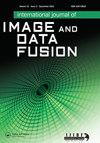基于深度学习的无监督自训练方法用于利用sentinel-1和sentinel-2图像的协同作用估计土壤水分
IF 1.8
Q3 REMOTE SENSING
International Journal of Image and Data Fusion
Pub Date : 2022-07-31
DOI:10.1080/19479832.2022.2106317
引用次数: 9
摘要
本文提出了一种新的无监督自训练方法(USTM)用于SM估计。首先,使用标记和未标记的数据训练ML模型。然后,通过添加代理标记数据,使用第二个模型生成伪标记数据。最后,利用第二模型生成的伪标记数据和未标记数据,应用第三模型估计SM。通过训练第三个模型得到最终的SM估计结果。随后,进行了现场测量以验证我们的方法。最后一个模型是无监督学习模型。利用哨兵- 1a和哨兵- 2a数据在突尼斯南部的两个不同地点进行了实验。输入数据包括Sentinel-1A的双模偏振后向散射系数(和),以及Sentinel-2A和原位数据的归一化植被指数(NDVI)和归一化红外指数(NDII)。与其他组合(人工神经网络(ANN)-CNN-CNN)和(极限梯度增强(XGBoost)-CNN-CNN)相比,基于随机森林(RF)-卷积神经网络(CNN)-CNN)的USTM方法可以获得最佳的性能和准确率。本文章由计算机程序翻译,如有差异,请以英文原文为准。
Unsupervised self-training method based on deep learning for soil moisture estimation using synergy of sentinel-1 and sentinel-2 images
ABSTRACT Here, we present a novel unsupervised self-training method (USTM) for SM estimation. First, a ML model is trained using the labeled and unlabeled data. Then, the pseudo-labeled data are generated employing the second model by adding a proxy labeled data. Eventually, SM is estimated applying the third model by pseudo-labeled data generated by the second model and unlabeled data. The final SM estimation result is obtained by training the third model. Subsequently, in-situ measurements are performed to validate our method. The final model is an unsupervised learning model. Experiments were carried out at two different sites located in southern Tunisia using Sentinel-1A and Sentinel-2A data. The input data include the backscatter coefficient in two-mode polarization ( and ), derived from Sentinel-1A, as well as the Normalized Difference Vegetation Index (NDVI) and the Normalized Difference Infrared Index (NDII) for Sentinel-2A and in-situ data. The USTM method based on (Random Forest (RF)- Convolutional neural network (CNN)-CNN) combination allowed obtaining the best performance and precision rate, compared to other combinations (Artificial Neural Network (ANN)-CNN-CNN) and (eXtreme Gradient Boosting (XGBoost)-CNN-CNN).
求助全文
通过发布文献求助,成功后即可免费获取论文全文。
去求助
来源期刊

International Journal of Image and Data Fusion
REMOTE SENSING-
CiteScore
5.00
自引率
0.00%
发文量
10
期刊介绍:
International Journal of Image and Data Fusion provides a single source of information for all aspects of image and data fusion methodologies, developments, techniques and applications. Image and data fusion techniques are important for combining the many sources of satellite, airborne and ground based imaging systems, and integrating these with other related data sets for enhanced information extraction and decision making. Image and data fusion aims at the integration of multi-sensor, multi-temporal, multi-resolution and multi-platform image data, together with geospatial data, GIS, in-situ, and other statistical data sets for improved information extraction, as well as to increase the reliability of the information. This leads to more accurate information that provides for robust operational performance, i.e. increased confidence, reduced ambiguity and improved classification enabling evidence based management. The journal welcomes original research papers, review papers, shorter letters, technical articles, book reviews and conference reports in all areas of image and data fusion including, but not limited to, the following aspects and topics: • Automatic registration/geometric aspects of fusing images with different spatial, spectral, temporal resolutions; phase information; or acquired in different modes • Pixel, feature and decision level fusion algorithms and methodologies • Data Assimilation: fusing data with models • Multi-source classification and information extraction • Integration of satellite, airborne and terrestrial sensor systems • Fusing temporal data sets for change detection studies (e.g. for Land Cover/Land Use Change studies) • Image and data mining from multi-platform, multi-source, multi-scale, multi-temporal data sets (e.g. geometric information, topological information, statistical information, etc.).
 求助内容:
求助内容: 应助结果提醒方式:
应助结果提醒方式:


